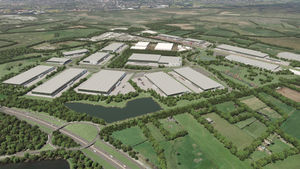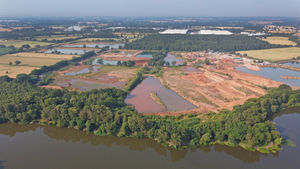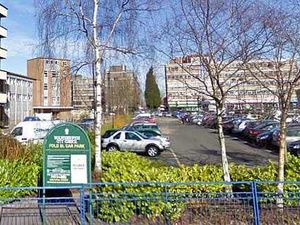West Midlands Interchange 'to create 8,500 jobs and bring major economic boost'
The arrival of a major rail freight terminal and logistics hub close to Wolverhampton is expected to deliver a huge boost to the regional economy.
The West Midlands Interchange at Four Ashes, between the city and Penkridge, is due to become operational in 2023 creating 8,500 full time jobs.
The first work on buildings on the 734-acre site is due to start in the new year.
Oxford Properties and Logistics Capital Partners have formed a joint venture to deliver the project which involves £1 billion initial investment.
James Markby, managing director of LCP, today stressed that LCP was in the project for the long term and it would not be a case of moving on to the next development. He said the project would involve more than a decade of development.
He said that the West Midlands Interchange would benefit the wider region economically and serve the conurbations of the West Midlands and Manchester as a central hub.
"The rail freight terminal is going to be a major economic benefit with mainline rail services connected to the park. That will influence the users that will come here. In effect it will be an inland port and it will take traffic off the roads," explained Mr Markby."

John Pagdin, head of UK for LCP, said the delivery of the eight million sq ft logistics park – the biggest in the UK – was "a massively exciting project" and was unique outside of London and the South East.
He said the 40 per cent of the workforce in the occupiers of the park would be highly skilled.
He said that it was expected another 8,000 jobs would be created through the distribution chain and in local businesses contributing to the project.
The developers are putting £4 million into a local fund with input from local councils to make sure employment opportunities are channelled locally.
The park and the construction will also benefit businesses in surrounding towns including Stafford and Telford.
"The most important part of a project like this is employment and that is no small part of why we selected this site," added Mr Pagdin.

Mr Markby stressed that the scheme was unique in that it would also have "green" credentials and would also deliver 50 acres of woodland, the creation and maintenance of two new country parks and see 12 hectare of farm land retained.
He added that in the wake of Brexit and Covid logistics real estate was in high demand and the development would play a big part in meeting the need for that in the Midlands.
Pierre Leocadio, head of investment for Europe at Oxford Properties, explained: “This transaction presents an exciting opportunity to develop a market leading, prime logistics hub, alongside our trusted partner, LCP.
"Oxford is renowned for its ability to deliver major large-scale projects, and this aligns with our strategy to deploy capital at scale into the logistics sector.
"The inclusion of a new rail terminal in the master plan allows us to create a site that has strong appeal to potential occupiers, while also helping reduce the environmental impact of its supply chain by reducing lorry traffic.
The site was acquired from the shareholders of Four Ashes Ltd, a three way partnership including Kilbride Holdings and Grosvenor Group’s Indirect Investment business (Grosvenor).
Peter Frost, director of Kilbride Holdings on behalf of Four Ashes, said: “Having successfully guided the development from its inception and earliest stages to development consent, we are pleased that partners Oxford Properties and LCP will bring funding and specialist expertise to enable the project to now fulfil its huge potential.”
Four-year campaign against use of the site
The plans for the massive strategic rail freight interchange were fiercely opposed by local residents.
Despite the scheme getting final approval from the Government back in May 2020 there was still widespread concern over the impact it would have on South Staffordshire, including the loss of valuable countryside.
The bitter four-year campaign against the site, which was chosen due to its proximity to the M6 and West Coast Mainline, failed to persuade the authorities and last-ditch efforts to secure a challenge to the decision from the district council failed in June last year.

There were hundreds of individual objections from people in surrounding villages to the site which will eat up more than 700 acres. Some claimed it could lead to the extinction of neighbouring communities.
Campaigners who opposed the controversial rail depot have since turned their attention to mitigating the impact of the development, which was originally put forward in April 2016 by Four Ashes Ltd that claimed it would lead to 8,500 new jobs for the area.
Leaders of the Stop the West Midlands Interchange group decided launching a judicial review, which could cost £50,000, was not something they could do on their own. Locals have warned the massive scheme, which will eat up the equivalent of 430 football pitches at Gailey, will destroy the Green Belt and cause traffic chaos on the roads with thousands of extra vehicles generated each day once it is in operation.
The protest group is working with the district council on a steering group to make sure the developers follow the development consent orders
Campaigners battled for four years to try and prevent the Interchange from going ahead but their fight ultimately proved to be fruitless.
The decision to approve the scheme was criticised by South Staffordshire MP Gavin Williamson – who is also the Education Secretary – who warned the project would create havoc, impacting traffic on the A449 and surrounding roads, increasing pollution and impacting on people’s quality of life.
He described it as “the wrong type of development for the wrong area”.
The campaigners claimed the freight hub depot would see 18,624 extra vehicles on the roads around Gailey, Calf Heath and Brewood each day, including 6,319 lorries, and involve demolition of some homes in the area to make way for buildings and new service roads.
Staffordshire County Council says it is aiming to minimise environmental damage and pressure on local roads from the development.





